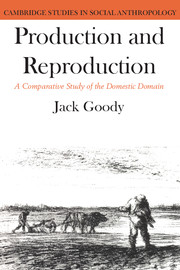Book contents
- Frontmatter
- Contents
- Tables
- Figures
- Preface
- Acknowledgements
- 1 The evolution of the domestic economy: the hoe and the plough
- 2 The theory, the variables and a test
- 3 Making causal inferences
- 4 Farming, labour and sex
- 5 Concubines and co-wives: the structure of roles in Africa and Eurasia
- 6 Adoption in cross-cultural perspective
- 7 Strategies of heirship
- 8 Class and marriage
- 9 Retrospect
- Appendix 1 Tables
- Appendix 2 The probability of family distributions
- Notes
- References
- Index
6 - Adoption in cross-cultural perspective
Published online by Cambridge University Press: 05 June 2012
- Frontmatter
- Contents
- Tables
- Figures
- Preface
- Acknowledgements
- 1 The evolution of the domestic economy: the hoe and the plough
- 2 The theory, the variables and a test
- 3 Making causal inferences
- 4 Farming, labour and sex
- 5 Concubines and co-wives: the structure of roles in Africa and Eurasia
- 6 Adoption in cross-cultural perspective
- 7 Strategies of heirship
- 8 Class and marriage
- 9 Retrospect
- Appendix 1 Tables
- Appendix 2 The probability of family distributions
- Notes
- References
- Index
Summary
Adoption plays a major part in the traditional law of many Eurasian societies. It occupies a large portion of Mayne's Treatise on Hindu Law and Usage (1878). The Babylonian code of Hammu-rabi, the oldest comprehensive set of written laws, gives a prominent position to ‘Adoption and Wet-nursing’ (Driver and Miles, 1952, 383–406). And the institution receives the same kind of attention in the law of China, Greece and Ancient Rome. Theoretically it has been of central importance in the writings of Sir Henry Maine and Fustel de Coulanges, where it is linked to the perpetuation of corporations of agnates over time.
In recent years much work has been done on the structure of such kinship corporations (usually known as unilineal descent groups) in Africa and elsewhere (e.g. Fortes, 1953) and, directly or indirectly, the work of Maine and Fustel de Coulanges has played some importance in the seminal studies of segmentary lineage systems in Africa. It is remarkable therefore that adoption is rarely, if ever, mentioned in these accounts of African societies; the institution is not discussed at all in the important studies by Evans-Pritchard of the Nuer (1951) and Fortes of the Tallensi (1949b). The situation of the Ashanti seems typical; legal analysts and sociological observers agree that adoption as such is not known in Ashanti law (Allott, 1966, 194).
- Type
- Chapter
- Information
- Production and ReproductionA Comparative Study of the Domestic Domain, pp. 66 - 85Publisher: Cambridge University PressPrint publication year: 1977

